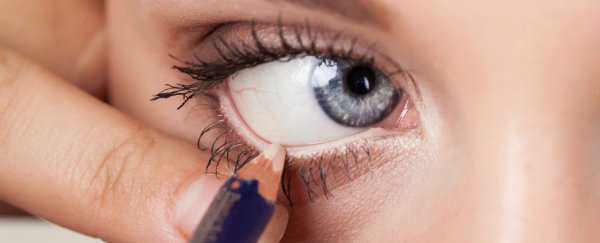For the first time, scientists have studied the effects of applying eyeliner to your inner eyelid, or 'waterline', to find that your risk of contamination, eye infections, and blurred vision is a whole lot higher than if you choose to apply it to your outer eyelids.
The researchers, led by Alison Ng from the Centre for Contact Lens Research at the University of Waterloo in Canada, followed the movement of eyeliner particles for two hours after application, and report that when drawn into the waterline, these particles more readily contaminate and alter the tear film of the eye - the thin layer of liquid that wards off foreign contaminants. If left unchecked, contamination can lead to discomfort and disease, particularly in those who wear contact lenses, or those with chronically dry and sensitive eyes.
"We noticed that the makeup migration happened quicker and was greater when eyeliner was put on the inner lid margin," Ng said in a press release.
The pilot study was carried out with three volunteers who were tested after using both the outer and inner eyelid techniques. They used pencil eyeliner infused with glitter to make the movement of the particles easier to detect. According to the paper published in the journal Eye & Contact Lens, the team used a slit lamp video recorder to track the particles as they became suspended in the tear film and moved about the eye over a two-hour period.
They found that within five minutes of application, up to 30 percent more foreign particles had made their way into the tear film when eyeliner was applied to the inner eyelid, and they moved much faster than the particles from the outer eyelid application. And once they're in your eye, these particles, which are made up of various waxes, oils, silicons and gums that are designed to make your eyeliner stay put, are very tricky for the eye's natural cleaning process to remove. After two hours, the team found that the particles had disappeared from the tear film, which suggests that they had migrated elsewhere internally or had been cleared out of the eye.
"People who wear contact lenses are most likely to notice some problems," said Ng. "If they have eyeliner stuck to their lenses, increasing deposits might cause vision disruption as the lens becomes cloudier."
Now, there are a whole lot of limitations to this study: they only included three participants; they used glitter eyeliner rather than solid coloured eyeliner, but say they'd expected similar results; and they didn't track the transfer of bacteria from the eyeliner to the eye. This is important, because it's well-known that the older an article of make-up is, the more bacteria it could harbour. So while it might not be cause to stop lining your inner eyelid straight away - let's face it, it looks really pretty - it's motivation to take steps to make it safer for your long-term eye health.
"If you thoroughly sharpen your pencil eyeliner before each application and get rid of the stuff that's stuck to the end, you'll have a fresh tip which can help prevent infection," said Ng. "With twist-up eyeliner, cut some off the end before each use. And always make sure to fully remove eye makeup before bed."
